 Extrude Boss
Extrude Boss
Introduction
This topic will explain the Extrude Boss function, will explain whereto find the function, and explain the options found in it.This topicwill also give a brief description of Dynamic Drawing, the Snap Incrementfunction, explain creation with quick steps and an example, and provide links to relatedtopics.
The Extrude Boss Function
The Extrude Boss function creates solid bodies by extruding closed wireframechains or planar surface geometry and automatically joins the intersecting(touching) entities into a single solid.When using a surface, the softwareautomatically extracts the edges of the surface to use for the boss.
Important: By default, ExtrudeBoss automatically merges all intersecting solids into a single solidbody, unless they are hidden using the ![]() Blank function in the document toolbar, or the Selected Bodies option is used to specify the bodies to interact with.Without the Selected Bodies option, hidinga layer does not exclude the entities on that layer from being affected by the Extrude Boss.
Blank function in the document toolbar, or the Selected Bodies option is used to specify the bodies to interact with.Without the Selected Bodies option, hidinga layer does not exclude the entities on that layer from being affected by the Extrude Boss.
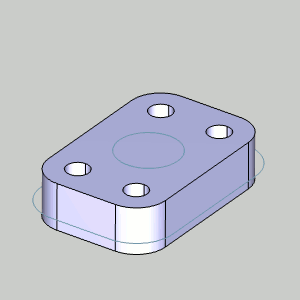
Dynamic Drawing
This function supports Dynamic Drawing which allows you to use a combination of sketching and data entry to create the entities. Prior to confirming the desired result in the function, an adjustable preview is visible. These previews can be modified using the sketch handles, data entry, or a combination of both. The benefit of Dynamic Drawing is that you can quickly place and adjust the size to get the approximate result, and then use data entry to update to the exact dimensions, and coordinate values as needed.
|
Preview with Sketch Handles |
Final Entities |
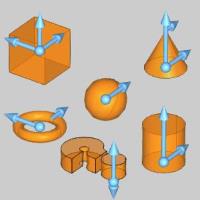
|
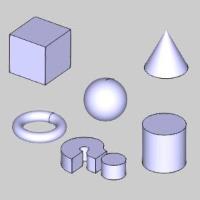
|
In the images above, we see the preview of entities which can be adjust with sketch handles, followed by those same entities after they are finalized.
Snap Increment
This function support the use of the snap increment when selecting the location of the entities. The snap increment allows you to get precise results when using mouse selection and helps to reduce data entry modifications.
To learn more, view Snap Increment.
Navigation
To open Extrude Boss:
- In the Extrude group, of the Create 3D ribbon, click
 Extrude Boss.
Extrude Boss.
The parameters display in theData Entry Manager.
The Data Entry Parameters
Selected Geometry
|
|
|
| The list will display all entities currently selected for the function. | |
Positive Direction
- Distance - sets the distanceof the extrusion from the selected geometry in the positive direction.You can use dynamic sketch handles or data entry to set this value.The snap increment appliesto the distance value when using sketch handles.
|
Distance Along Z-Axis |
Distance Along Normal |
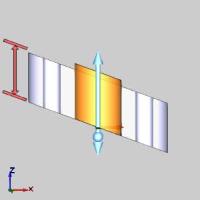
|
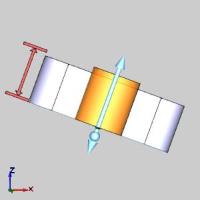
|
-
DraftAngle - creates an angle along the edge of the extruded shapein the positive direction.This also applies to any internal shapeswhen you select more than one curve to extrude.This can be a positiveor negative value.
Draft Along Z-Axis
Draft Along Normal
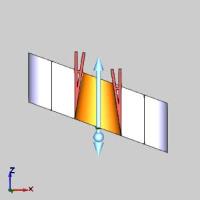

Other Direction
- Distance - sets the distanceof the extrusion from the selected geometry in the negative direction.You can use dynamic sketch handles or data entry to set this value.The snap increment appliesto the distance value when using sketch handles.
-
DraftAngle - creates an angle along the edge of the extruded shapein the negative direction.This also applies to any internal shapeswhen you select more than one curve to extrude.This can be a positiveor negative value.
Options
-
 AlongNormal - the extrusion occurs parallel to the normal directionof the plane created by the selected curve.
AlongNormal - the extrusion occurs parallel to the normal directionof the plane created by the selected curve.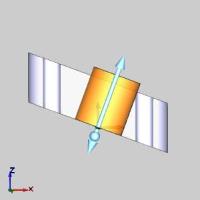
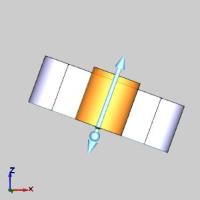
FrontView 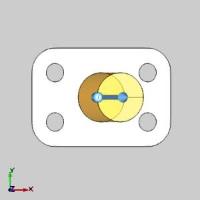

TopView
-
 AlongZ-Axis - the extrusion direction is the Z-axis regardless ofhow the selected curve is oriented.
AlongZ-Axis - the extrusion direction is the Z-axis regardless ofhow the selected curve is oriented.
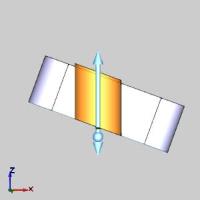
FrontView 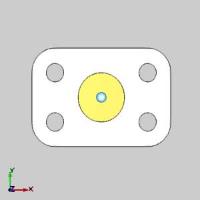
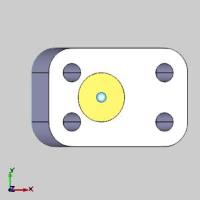
TopView
 Scope
Scope
-
 All Bodies - With this option selected, all intersecting solid bodies not set to a
All Bodies - With this option selected, all intersecting solid bodies not set to a  Blank state will be affected by this feature. This includes bodies on layers set to a hidden state.
Blank state will be affected by this feature. This includes bodies on layers set to a hidden state. -
 Selected Bodies - With this option selected, only those intersecting solid bodies added to the selected geometry list below will be affected by this feature.
Selected Bodies - With this option selected, only those intersecting solid bodies added to the selected geometry list below will be affected by this feature.
Selected Geometry
|
|
|
| This list box will show the entities currently selected for the function. | |
- OK - finalizes the function.
- Cancel - exits the function.
Quick Steps - Extrude Boss
|
Start |
Finish |
|

|

|
-
Open the function and define all Data Entryparameters.
-
Select geometry in the graphics area.
This can sometimes be made easier by pressing Sto turn off the shaded view, as seen below.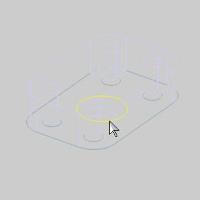
The geometry can be closed wireframe chains, surface edges, or planarsurface geometry.When using a surface, the software automaticallyextracts the edges of the surface to use for the boss.
With geometry selected, the preview appears.
-
Use the dynamic sketch handles, with or without snapincrement, and/or data entry to update the CAD preview as needed.
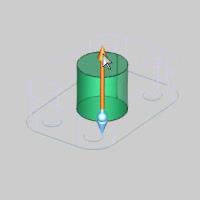
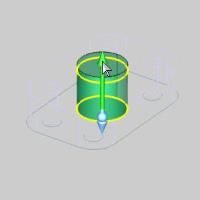
-
In the Data Entrytab, click OK to create theentity.

The feature is added to the CAD Tree. -
Click Cancelto close the function.
Note: By default the Scope section is set to All Bodies, which is fine for this example.In situations where another body may intersect, which should not be included in the boolean, use the Selected Bodies option to specify which bodies should be included in the boolean.
Example
A BobCAD file installed with the software can be opened to follow alongwith this example.This example will have you:
- Open the Example File
- Open Extrude Boss
- Create the First Extrude Boss
- Create the Second Extrude Boss
- Create the Third Extrude Boss
- Understanding and Verifying the Result
- Modifying CAD Features
Part 1) Open the Example File
-
In the Quick Access Toolbar, click
 Open.
Open. -
Navigate to: C:\BobCAD-CAMData\BobCAD-CAM V**\Examples, and select ExtrudeBoss Example.bbcd.
-
With ExtrudeBoss Example.bbcd displaying in the FileName box, click Open.
Part 2) Open Extrude Boss
To open Extrude Boss:
- In the Extrude group, of the Create 3D ribbon, click
 Extrude Boss.
Extrude Boss.
The parameters display in theData Entry Manager.
Part 3) Create the First Extrude Boss
For the first Extrude Boss, we use data entry only.
Tip: Forthe creation of the initial solid, you could also use Extrude Curve andget the same result.The Extrude Boss will combine any intersecting solidor surface, even if that intersecting solid or surface is on a hiddenlayer.
-
In the Data Entry Manager under PositiveDirection, double-click in the Distancebox to select all the text.
Type 0.625 to update the Distancevalue. -
In the graphics area, click and drag a windowto select the wireframe flange shape.
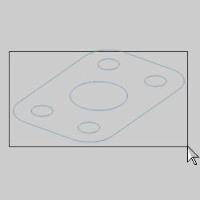
The entities go into the Selected Geometry list and the Preview appears.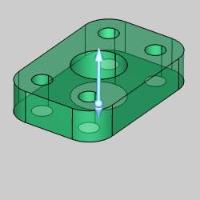
-
In the SelectedGeometry list, highlight Arc-10.
The arc highlights in the graphics area.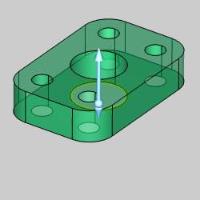
-
With Arc-10 highlighted in the Selected Geometrylist, click
 (Delete).
(Delete).
The arc is removed from the Extrude Boss Preview.
Note: The centercircle is removed because it is used later to create another boss.Theother four circles are selected because we want them to create the holesfor the flange.By including these in the first extrude, we eliminatethe need to cut the holes using another CAD function.
-
Leave the Scope set to All Bodies, and click OK to confirm.
The Extrude Boss is created in the graphics area and an ExtrudeBoss feature is created in the
ExtrudeBoss feature is created in the  CADTree.
CADTree.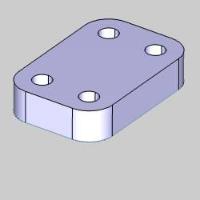
That is all that is needed to create an Extrude Boss feature.
Leave the Extrude Boss function open.Another boss is created in thenext part of this example.
Important
Before moving on with the example, there are a few important notes aboutExtrude Boss.
-
Do notdelete the input (wireframe) geometry after using it to create a solid.The wireframe geometry must remain in the file, because if you deleteit, the CAD feature will fail when the CAD Tree is rebuilt.This appliesto any solid created from wireframe geometry, not just Extrude Boss.
Tip: You maywant to keep all wireframe geometry on a separate CAD layer so that youcan hide and show it as needed.(This is done in the example file usingone layer named Wireframe and another layer named Solid.) To learn moreabout using layers, view TheLayers Manager.
-
With the Scope set to All Bodies, the Extrude Boss function merges all intersecting solid bodiesin the file into a single solid.
Tip: You canexclude solids from being merged by Extrude Boss using the ![]() Blankfunction, found in the document toolbar, to hide the solids you don't want to merge.If the CAD Tree isrebuilt it must, again, be Blanked, as if it is not, it will be mergedwith the Boss when the CAD Tree is rebuilt.When merging specific bodies, utilize the Selected Bodies option.In cases no bodies should be added to the result,it may be better to use the Extrude Curve function in the Extrude group, of the Create 3D ribbon.The Extrude Curve creates solids as well, but it doesn't merge solidbodies.
Blankfunction, found in the document toolbar, to hide the solids you don't want to merge.If the CAD Tree isrebuilt it must, again, be Blanked, as if it is not, it will be mergedwith the Boss when the CAD Tree is rebuilt.When merging specific bodies, utilize the Selected Bodies option.In cases no bodies should be added to the result,it may be better to use the Extrude Curve function in the Extrude group, of the Create 3D ribbon.The Extrude Curve creates solids as well, but it doesn't merge solidbodies.
-
With the Scope set to Selected Bodies, the Extrude Boss function merges only the selected intersecting solid bodiesinto a single solid.
Part 4) Create the Second Extrude Boss
For the second Extrude Boss, we explore Dynamic Drawing.
-
Under PositiveDirection, click in the right side of the Distancebox so the cursor displays after the current value of 0.625.
-
Type +0.05and press Tab to update thevalue.
The value displays 0.675. -
To make it easier to select the geometrypress S, or in the document toolbar, click
 Shaded.
Shaded.
The Shading disappears.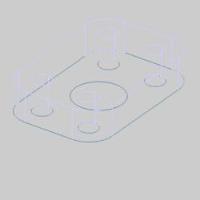
-
Hover over the center arc as shown in theimage below.
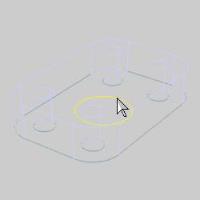
-
The CAD preview displays.
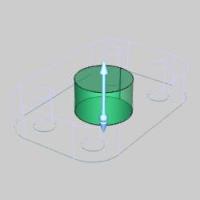
-
Under the graphics area, change the valueof the
 (SnapIncrement) to 0.2500.
(SnapIncrement) to 0.2500.
This allows us to sketch CAD sizes and depths in increments of 0.2500. -
Now to show how to use the dynamic sketchhandles.
Hover over the lower sketch handle to highlight it.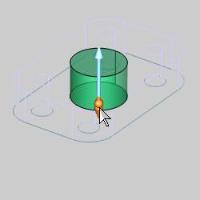
-
Click to select the lower sketch handle.
The sketch handle highlights and shows the next possible position basedon our Snap Increment.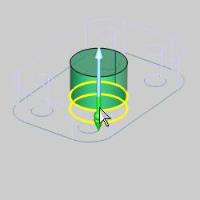
-
Move the sketch handle down slightly.
The Preview displays the next possible position based on our Snap Increment.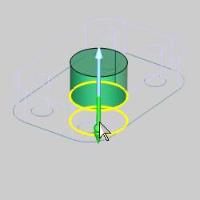
-
Move the sketch handle back to the 0.2500 position and click to setit to create a small extrusion on the underside of the part.
The Preview updates to show the current Other Direction amount.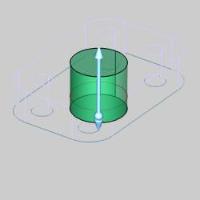
-
To confirm the selection, click
 (OK).
(OK).
The Extrude Boss is created in the graphics area and another ExtrudeBoss feature is created in the
ExtrudeBoss feature is created in the  CADTree.
CADTree.
-
Pres S,or select
 Shaded from thedocument toolbar.
Shaded from thedocument toolbar.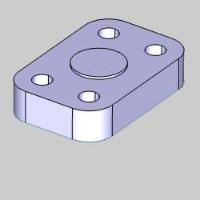

Leave the Extrude Boss function open.Anotherboss is created in the next part of this example.
Part 5) Create the Third Extrude Boss
-
Hover over the center extrusion as seen inthe image below.
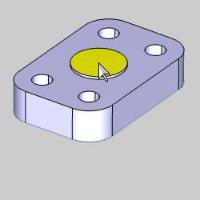
-
Click the highlighted surface.
The Preview displays.
-
In the PositiveDirection group, change the Distanceto 0.2500.
The Preview updates.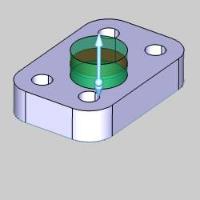
-
In the DraftAngle box, type 45.00,and press Tab.
Note: The DraftAngle can be a positive or negative value.
The Preview updates.
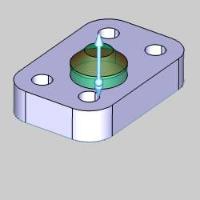
Note: As youcan see here, we are extruding in two different direction using a differentdraft angle on top.Although the Other Direction of the extrusion is thevalue we used for the second extrusion, this will not affect our currentextrusion, and therefore, does not have to be changed.
-
To finish the third extrude, click OKin the Data Entry Manager.
The Extrude Boss is created in the graphics area a third ExtrudeBoss feature is created in the
ExtrudeBoss feature is created in the  CADTree.
CADTree.
-
To close the Data Entry Manager, click Cancel.
Part 5) Understanding and Verifying the Result
It is important to understand that the Extrude Boss function mergesall intersecting solid bodies into a single solid body.The CAD Tree helpsto illustrate this fact.When you close the Data Entry Manager, the CADTree Manager automatically displays.
-
Notice that there are three Extrude Bossfeatures in the CAD Tree.
The CAD Tree provides many tools to help you modify, verify, and organizeyour CAD features.
If you enable selection mode and point to the solid in the graphicsarea, you can see that it highlights as a single solid body.
Another way to confirm this is to use the Solids folder in the CADTree. -
Double-click the
 Solids folder to expand it, or,click the small
Solids folder to expand it, or,click the small  plus sign.
plus sign.
Notice that there is one item, Solid1.
Click Solid 1 to highlightthe solid body in the graphics area.
All of the feature items in the CAD Tree show a preview when you clickthem. -
Click the first Extrude Boss feature in theCAD Tree, and notice the result of the feature is highlighted in thegraphics area.
To make this easier to view, in the LayersManager, right-click Solid andclick Hide.
Note: Noticethat there are no longer any items in the Solids folder of the CAD Tree.The Solids folder only contains Solid items that are currently visiblein the graphics area.Hiding the Solid layer temporarily removes the Soliditem from the Solids folder.
-
Click each feature and geometry item in the CAD Tree to viewthe result or selection of the feature, respectively.Expand eachfeature if needed.
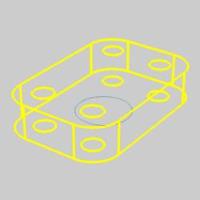
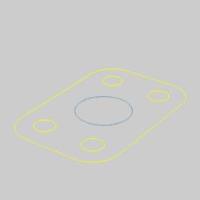
-
In addition to the highlighting of CAD feature results and geometryselection, the CAD Tree also provides modification tools as explainedin the next part of this example.
-
In the Layer Manager, right-click Solidand click Show.
Part 6) Modifying CAD Features
The CAD Tree Manager allows you to modify the parameters and/or geometryselection of solid features that you create.Numerous ways are providedso you can use the most efficient method depending on what you need toaccomplish.All of this information is explained in TheCAD Tree.The following steps provide two examples.
-
Right-click
 ExtrudeBoss under Flange 5 Hole, and click Edit.
ExtrudeBoss under Flange 5 Hole, and click Edit.
The Extrude Boss function opens with the CAD preview.The associatedgeometry is already in the Selected Geometry list.The condition ofthe model is the same as it was when you created the feature.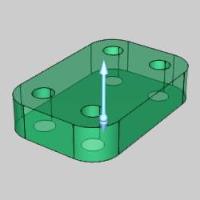
-
Under PositiveDirection, change the Distancevalue to 0.500.
The Preview updates.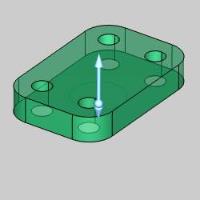
-
In the DraftAngle box, type -5.000.
The Preview updates.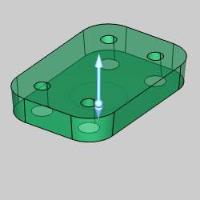
-
To finish editing the feature, click OK.
The CAD feature is automatically rebuilt with the new parameters.
TheCAD Tree provides the tools to help you easily modify CAD models toaccommodate design changes.
This concludes the example.View the ExtrudeCut Example to learn about cutting the hole in the center of the flangecreated in this example.






 (Delete All)
- removes all entities from the Selected Geometry list.
(Delete All)
- removes all entities from the Selected Geometry list.